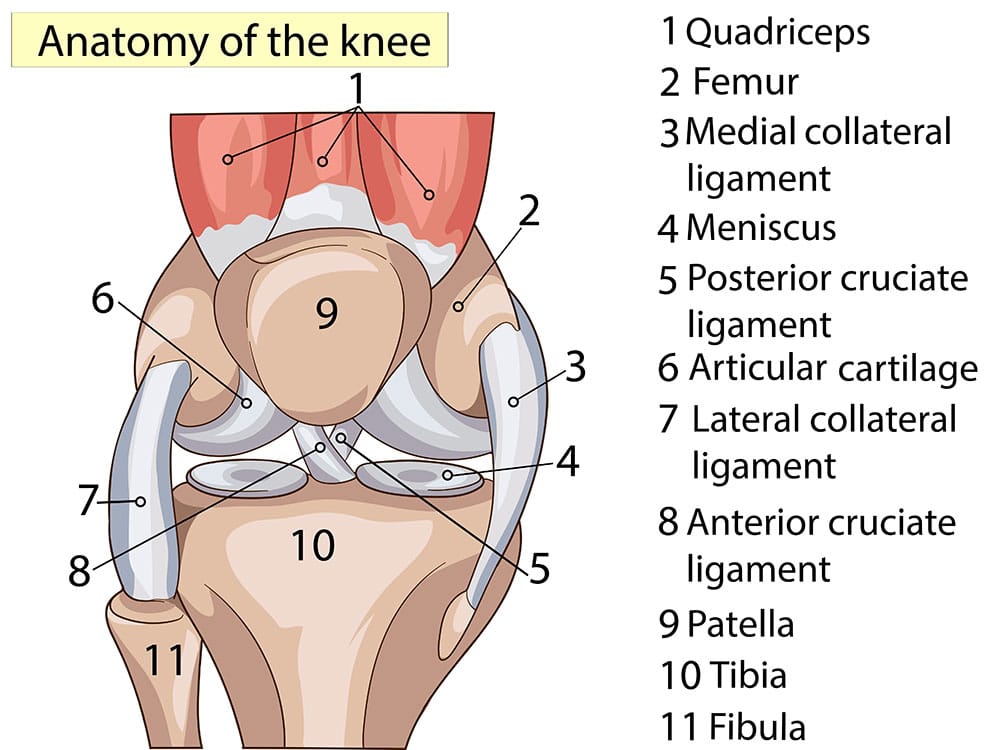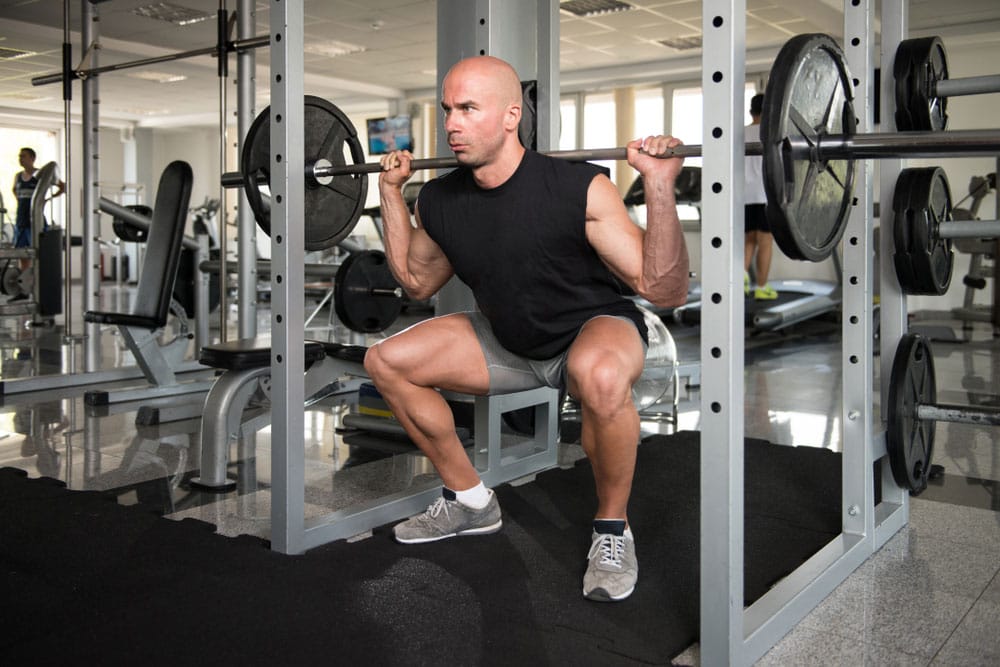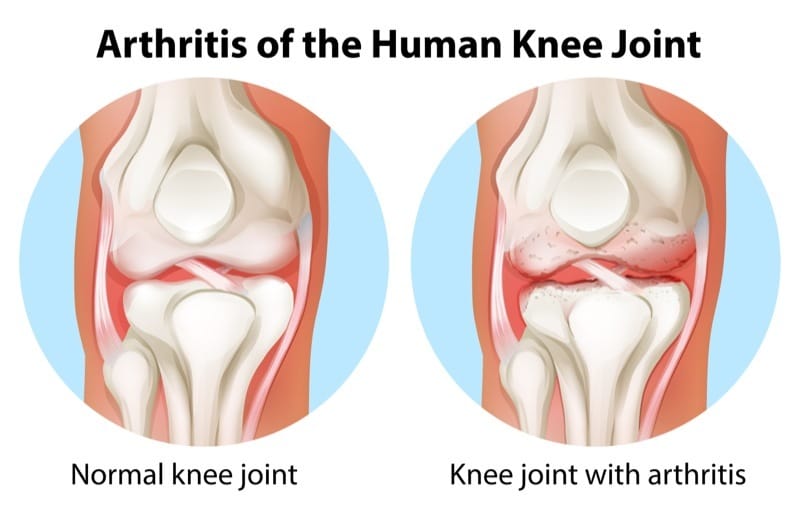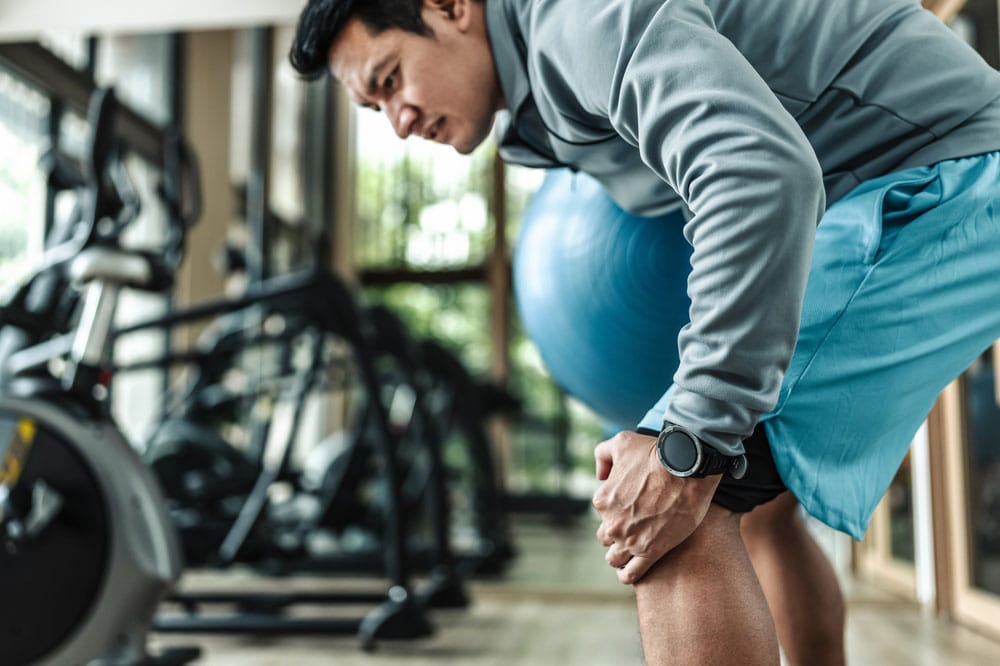Why Are My Knees Crackling When Squatting?
Learn about your knees crackling when squatting and why this happens. Learn knee anatomy and fixes to knee pain in squats.
Is it normal for your knees to crackle when you squat?
The science says yes. Noisy knees can happed to anyone. But your knees crackling when squatting can put even the most advanced weightlifters ill at ease. Just because there SOUNDS like there’s something wrong, does that mean there really is?
You may still be surprised at what’s going on in your body if your knees are crackling when squatting.
In this article, we’ll review the knee joint and its anatomy. Next, we’ll look at what kind of pressure is applied to your knees when you squat.
Finally, we’ll see what strategies you can take to reduce or control the impact of your knees crackling when squatting.
Take a read onward to reduce your knee noise and hopefully save yourself any awkwardness in the gym.
Knee Joint and Anatomy

The knee joint is also called the patellofemoral joint.
Why?
The name described the juncture where your patella, aka your kneecap and your femur— the thighbone— meet.
This intersection is separated by a layer of cartilage. It keeps your kneecap gliding smoothly to help you in exercises like running, jumping, or squatting.
The knee joint is the largest in your body and connects your thigh to your lower leg.
The knee is made up of:
- Tendons: Quadriceps tendon, hamstring tendon, patellar tendon
-
- Ligaments: medial collateral ligament (MCL), lateral collateral ligament (LCL), anterior cruciate ligament (ACL) and posterior cruciate ligament (PCL)
- Bones: Femur, tibia, patella
-
- Muscles: biceps femoris, semimembranosus, and semitendinosis
- Nerves
- Cartilage
All of these components work together in healthy knees. But when your knees start to deteriorate, whether through improper squat form, injury, or old age, the cartilage may wear down, causing the bones to rub or scrape against each other.
Why are my knees crackling when squatting?

There are several potential reasons your knees may be crackling when squatting. It’s important to notice that most people whose knees crack during squats aren’t cracking because of the squatting itself, but due to other factors.
Let’s take a look at a few of the most common ones.
Knee Crepitus
Knee crepitus is a common cause of creaky knees. This can manifest as a popping, cracking, or clicking noise to the knees.
The name and the noises sound a little bit scary.
But often it comes from benign causes. How do you know whether crepitus is dangerous?
Ask yourself whether your knees are hurting when you squat or just making a lot of noise. Noise is fine as long as it’s not accompanied by pain.
When it hurts, stop.
If you’re not feeling any pain when you squat, feel free to keep going as long as it’s comfortable.
Patellofemoral Pain Syndrome
Patellofemoral Pain Syndrome, or PFP (say that five times fast!) is a pain at the front of your kneecaps. We also sometimes call it “runner’s knee.”
Although it’s common to see in runners, anyone who plays a sport that involves jumping or a lot of pounding wear and tear on the knees can experience PFP.
What causes patellofemoral pain syndrome?
It’s helpful to think back to the structure of the knee joint that we saw in the first part of this article.
We know that the knee is also called the patellofemoral joint and connects your patella (kneecap) to your femur. When the pressure between kneecap and femur is more intense than usual due to exercise, it can wear down the cartilage that separates these two bones.
If you keep this up over time, it can cause pain in the knees.
In distance running, especially, it’s common to do a large number of miles on your feet per week.
According to recent running statistics, race participation has grown by over 50% in the last decade. As longer distances like marathons, half marathons, and ultramarathons increase in popularity more people are putting a lot of strain on their knee joints by pounding the pavement.
If you’re a participant in Couch to 5K or another similar running series, where you go from sedentary to frequent running training, it’s possible to see PFP, since your knees aren’t used to the exertion.
Knee Osteoarthritis

Knee osteoarthritis means the loss of cartilage in your knees from wear and tear. This is usually but not always caused by older age.
You can experience primary osteoarthritis, related to age or hormonal changes or secondary osteoarthritis, due to health conditions, lifestyle, or any reason other than natural aging.
This condition often causes a buildup of a substance called synovial fluid, the liquid that lubricates your joints.
This excess of fluid is your body’s response to dry or immobile joints to attempt to compensate. But oftentimes, this excess fluid actually causes bloating in your joints and can increase the pain and creakiness.
Aging
Ahhhh, the beauty of getting old.
Whether you’re the healthiest person in the world or not, age hits all of us.
And with it comes a reduction in healthy knee cartilage.
Articular cartilage aging is strongly associated with osteoarthritis, but it’s not inevitable that your cartilage will degenerate as you get older.
That being said, over time, most people do see a thinning of cartilage in their knees.
Read more about this connection in Aging Cartilage and Osteoarthritis.
Are knees crackling when squatting dangerous?
No.
As a general rule, it’s perfectly safe for your knees to make some cracking or crackling noises in a squatting position, provided your joints are generally healthy.
The bottom line is that what’s healthy is usually what feels normal for you and occurs pain-free.
If you experience hip pain when squatting or lower back pain when squatting, you’ll want to alter your squat form.
Squats should feel challenging, but not excruciating.
Any pain in your body during squats that feels sharp or stabbing is not a good sign.
This can be a message to your body that you either need to reduce your load or change up your form. Pain in certain areas can be a symptom of repetitive strains.
If you squat with improper form, again and again, you’re incorrectly loading your joints every time.
Compounded over so many sets of squats, it’s inevitable that this will lead to injury or chronic joint pain.
How can I stop my knees crackling when squatting?

Although some people are more predisposed to have louder knees, there are a few hacks you can use to stop your knees from making noise.
Strengthening your knee muscles
If you make the muscles surrounding your knee joints strong, they’ll do a lot to support any weaknesses that you have in the joints themselves.
Work on strengthening your:
- Quadriceps
- Hamstrings
- Hips
- Glutes
- Ankles.
Strength in all of these lower body muscles is a great way to improve overall knee strength and health.
Assisted squats are a great way to do this if you notice knee pain or crackling in traditional squats. Here are some squat and hack squat alternatives you can try:
Weight loss
Oftentimes, the pressure on your joints is caused by higher body weight.
If you are overweight, you’re putting more load on your joints than they are designed to handle.
To reduce your overall body fat, it’s important to burn more calories than you consume daily.
To do this, you can:
- Participate in activities that are known to burn more calories, including cardiovascular or aerobic exercise.
- Aim to consume filling foods to curb your hunger and reduce junk food cravings so you don’t overeat. Lean proteins, like chicken, fish, beans or tofu are good staple foods to include in your diet.
- Increase your hydration levels so you don’t mistake thirst cues with hunger.
- Aim to get a proper night’s sleep so your body is well-rested to repair your muscles and reduce stress. This can be an emotional motivator that stops you from overeating and can help regulate hormones associated with hunger.
Better squat form
Over time, poor squat form can cause your knee joints to rub at the bones.
Make sure to keep your form. To do that, here’s a crash course on how to squat properly.
- Set-Up: Stand with your feet shoulder-width apart or slightly wider. Point your toes out slightly at around a 15-degree angle. Engage your core muscles and keep your spine neutral. Hold your chest proud.
- Equipment: Place a loaded barbell across your upper back. The bar should sit across the tops of your trapezius muscles. Grip the bar with your hands facing forward. Keep them slightly wider than shoulder-width apart.
- Squat: Hinge from your hips as you bend your knees. Think about making the motion of dropping back to sit on a chair. Keep your weight on your heels and lower your body down until your thighs come to a 90-degree angle with your shins. Make sure your knees are tracking in line with your toes and that they don’t knock inward.
- Reverse: Drive out of your heels, and push the floor away from you to come back up. At the top of the move, extend your hips and squeeze your butt slightly.
- Reps: Beginners should aim for 3 sets of 10 reps. If you’re squatting for strength, aim for 3 sets of 3-6 reps or try a one-rep max with heavy weight. If you’re squatting for hypertrophy, aim for 3 sets of 8-12 reps.
For more recommendations on squat load, see Loading Recommendations for Muscle Strength, Hypertrophy, and Local Endurance.
If you’re totally new to this exercise, have a friend on hand who knows how to spot a squat.
Follow these recommendations to practice safe squats and you should be able to avoid your knees crackling when squatting.
Save your knees and your workout progress. The Flex App progresses as you do with plate tracking capabilities and auto progression.
References
Drum, E. E., Kovats, A., Jones, M. D., Dennis, S., Naylor, J., Mills, K., & Thom, J. M. (2023). Creaky knees: Is there a reason for concern? A qualitative study of the perspectives of people with knee crepitus. Musculoskeletal care, 21(4), 1114–1124. https://doi.org/10.1002/msc.1793
Hsu H, Siwiec RM. Knee Osteoarthritis. [Updated 2023 Jun 26]. In: StatPearls [Internet]. Treasure Island (FL): StatPearls Publishing; 2024 Jan-. Available from: https://www.ncbi.nlm.nih.gov/books/NBK507884/
Loeser, R.F. Jr. Aging Cartilage and Osteoarthritis--What's the Link?.Sci. Aging Knowl. Environ.2004,pe31-pe31(2004).DOI:10.1126/sageke.2004.29.pe31
Martin, J. A., & Buckwalter, J. A. (2001). Roles of articular cartilage aging and chondrocyte senescence in the pathogenesis of osteoarthritis. The Iowa orthopaedic journal, 21, 1–7.
Schoenfeld, B. J., Grgic, J., Van Every, D. W., & Plotkin, D. L. (2021). Loading Recommendations for Muscle Strength, Hypertrophy, and Local Endurance: A Re-Examination of the Repetition Continuum. Sports (Basel, Switzerland), 9(2), 32. https://doi.org/10.3390/sports9020032
Related articles


Get fit with Flex
Build muscle & lose weight fast for free.
Available on iPhone + Apple Watch





